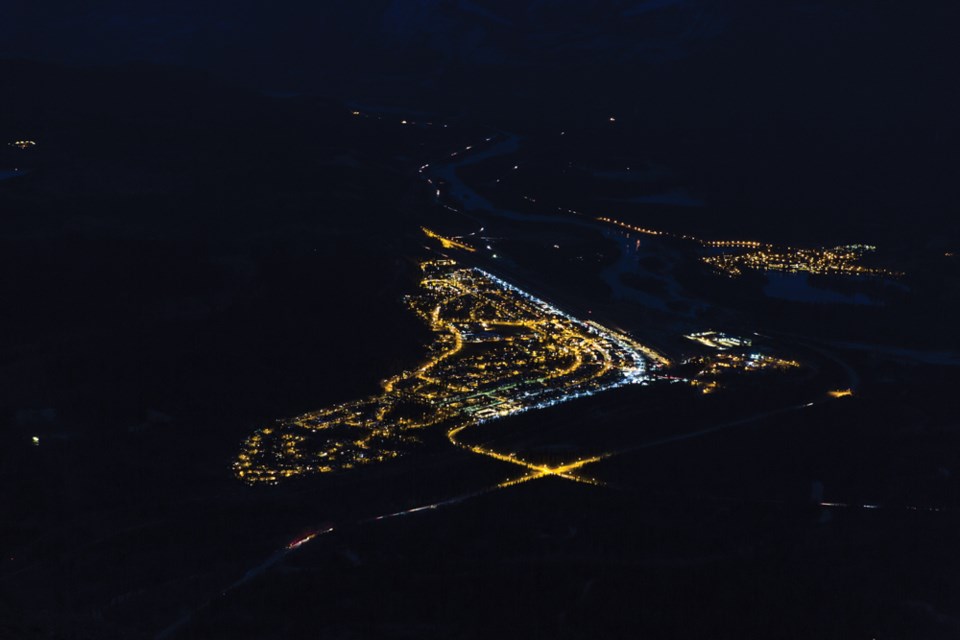
Living within the second largest dark sky preserve in the world offers some spectacular evenings, but there’s a lot more to a dark sky preserve than just being able to see the stars.
In 2011, Jasper National Park was officially recognized as a dark sky preserve by the Royal Astronomical Society of Canada, a non-profit organization devoted to the advancement of astronomy and related sciences in Canada.
Since becoming a dark sky preserve, Parks Canada has embraced the designation, implementing various policies in the park to reduce light pollution and programs to educate the public.
“In Alberta, other than the far north, the only place where it is truly dark is in the Rocky Mountains,” said Rogier Gruys, a product development specialist with Parks Canada.
According to Gruys, Parks Canada has eight sites across the country that are officially designated as dark sky preserves and Canada has more dark sky preserves than all other countries in the world combined.
In fact, if you combine Jasper National Park and Wood Buffalo National Park, which was designated the world’s largest dark sky preserve in 2013, the two parks combined are larger in area than all other dark sky preserves in the world.
In order to maintain its dark sky status, Parks works with various businesses and organizations in town to reduce Jasper’s light pollution through the installation of responsible lighting.
“It’s not about turning off lights, its about responsible lighting,” said Rogier. “That means shielded light fixtures that point downwards and making use of timers and motion sensors to only turn on the lights when you really need them.”
He pointed to Robinsons Foods as a good example of a business that uses responsible lighting, as well as Jasper Junior/Senior High School which were both rebuilt in recent years.
Other notable businesses include the Fairmont Jasper Park Lodge, which has begun to replace and change its lighting to be dark-sky friendly.
Despite the improvements, Rogier said there is still a lot more to be done, particularly when it comes to the town’s street lights.
“It will take a while, because it’s not cheap, but slowly we are beginning to make those changes so that ultimately in the next decade or so all lights will be dark-sky friendly,” said Rogier.
While reducing light pollution is important to be able to see the stars, it’s also important for the park’s flora and fauna.
“Protecting nocturnal habitat is part and parcel with what we do and in a sense, national parks right across the country are already dark sky preserves because we’re protecting these places,” said Brian Catto, a park interpreter.
“We don’t just look at the species and the landscape when we’re looking at protection, we look at protecting all the natural processes that go along with the environmental, like the flow of water or the exchange of air, and one of the natural processes that’s very important to all life on Earth, a natural process that all of our ancestors evolved with, was the regular rhythm of night and day.”
During his presentation at the festival, Oct. 15, he highlighted several animals and plants in the park that rely on the dark to survive such as the little brown bat, the wood frog, and the twin flower.
“A lot of amphibians depend on darkness for their reproductive cycle, but when we have a little bit of light pollution it can disrupt their cycles and they might not be as successful when reproducing,” explained Catto, adding that many plants have also evolved and adapted to the dark.
“Take the little twin flower for example. This is a tiny little flower. You can walk through the forest here in Jasper and completely miss it because it is so small, but if you go walking at night you’re going to smell a slight odour in the air, it’s the twin flower that is pumping out this odour that smells a lot like licorice,” said Catto.
According to him, the odour attracts moths, which help pollinate the flowers, allowing the plant species to reproduce.
During his presentation he also reminded the audience that darkness is important to human health.
“Just like every creature we evolved with the regular rhythm of night and day. We need darkness to be healthy,” said Catto.
According to Catto, at night humans produce melatonin, a hormone that helps us sleep.
Wrapping up his presentation, he highlighted various nighttime programs offered by Parks Canada throughout the year, from camping under the stars at Marmot Meadows to catch the Perseid meteor shower in August, to sharing indigenous stories and perspectives about the constellations in the sky.
“By coming out into the park after dark, leaving the cell phone and iPad behind, disconnecting from all of that artificial light is actually a very important thing to do.”
Paul Clarke [email protected]
